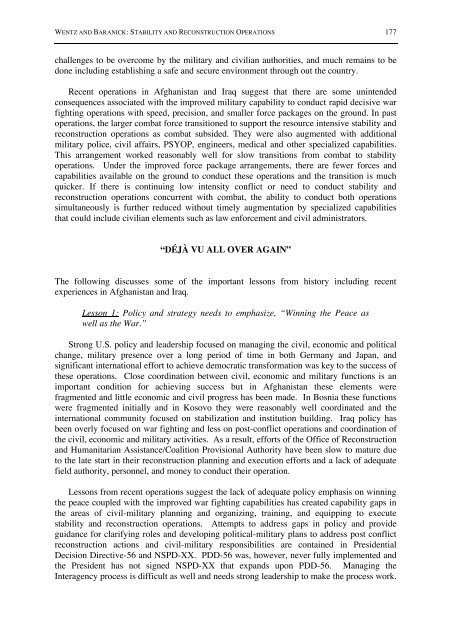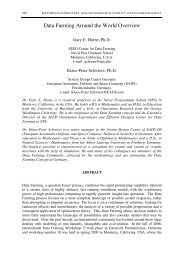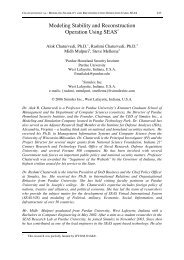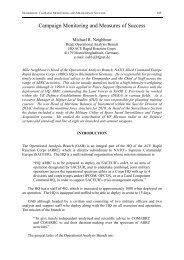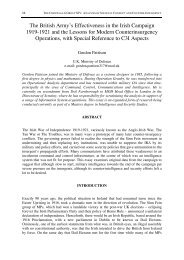Stability and Reconstruction Operations: What ... - Cornwallis Group
Stability and Reconstruction Operations: What ... - Cornwallis Group
Stability and Reconstruction Operations: What ... - Cornwallis Group
You also want an ePaper? Increase the reach of your titles
YUMPU automatically turns print PDFs into web optimized ePapers that Google loves.
WENTZ AND BARANICK: STABILITY AND RECONSTRUCTION OPERATIONS 177<br />
challenges to be overcome by the military <strong>and</strong> civilian authorities, <strong>and</strong> much remains to be<br />
done including establishing a safe <strong>and</strong> secure environment through out the country.<br />
Recent operations in Afghanistan <strong>and</strong> Iraq suggest that there are some unintended<br />
consequences associated with the improved military capability to conduct rapid decisive war<br />
fighting operations with speed, precision, <strong>and</strong> smaller force packages on the ground. In past<br />
operations, the larger combat force transitioned to support the resource intensive stability <strong>and</strong><br />
reconstruction operations as combat subsided. They were also augmented with additional<br />
military police, civil affairs, PSYOP, engineers, medical <strong>and</strong> other specialized capabilities.<br />
This arrangement worked reasonably well for slow transitions from combat to stability<br />
operations. Under the improved force package arrangements, there are fewer forces <strong>and</strong><br />
capabilities available on the ground to conduct these operations <strong>and</strong> the transition is much<br />
quicker. If there is continuing low intensity conflict or need to conduct stability <strong>and</strong><br />
reconstruction operations concurrent with combat, the ability to conduct both operations<br />
simultaneously is further reduced without timely augmentation by specialized capabilities<br />
that could include civilian elements such as law enforcement <strong>and</strong> civil administrators.<br />
“DÉJÀ VU ALL OVER AGAIN”<br />
The following discusses some of the important lessons from history including recent<br />
experiences in Afghanistan <strong>and</strong> Iraq.<br />
Lesson 1: Policy <strong>and</strong> strategy needs to emphasize, “Winning the Peace as<br />
well as the War.”<br />
Strong U.S. policy <strong>and</strong> leadership focused on managing the civil, economic <strong>and</strong> political<br />
change, military presence over a long period of time in both Germany <strong>and</strong> Japan, <strong>and</strong><br />
significant international effort to achieve democratic transformation was key to the success of<br />
these operations. Close coordination between civil, economic <strong>and</strong> military functions is an<br />
important condition for achieving success but in Afghanistan these elements were<br />
fragmented <strong>and</strong> little economic <strong>and</strong> civil progress has been made. In Bosnia these functions<br />
were fragmented initially <strong>and</strong> in Kosovo they were reasonably well coordinated <strong>and</strong> the<br />
international community focused on stabilization <strong>and</strong> institution building. Iraq policy has<br />
been overly focused on war fighting <strong>and</strong> less on post-conflict operations <strong>and</strong> coordination of<br />
the civil, economic <strong>and</strong> military activities. As a result, efforts of the Office of <strong>Reconstruction</strong><br />
<strong>and</strong> Humanitarian Assistance/Coalition Provisional Authority have been slow to mature due<br />
to the late start in their reconstruction planning <strong>and</strong> execution efforts <strong>and</strong> a lack of adequate<br />
field authority, personnel, <strong>and</strong> money to conduct their operation.<br />
Lessons from recent operations suggest the lack of adequate policy emphasis on winning<br />
the peace coupled with the improved war fighting capabilities has created capability gaps in<br />
the areas of civil-military planning <strong>and</strong> organizing, training, <strong>and</strong> equipping to execute<br />
stability <strong>and</strong> reconstruction operations. Attempts to address gaps in policy <strong>and</strong> provide<br />
guidance for clarifying roles <strong>and</strong> developing political-military plans to address post conflict<br />
reconstruction actions <strong>and</strong> civil-military responsibilities are contained in Presidential<br />
Decision Directive-56 <strong>and</strong> NSPD-XX. PDD-56 was, however, never fully implemented <strong>and</strong><br />
the President has not signed NSPD-XX that exp<strong>and</strong>s upon PDD-56. Managing the<br />
Interagency process is difficult as well <strong>and</strong> needs strong leadership to make the process work.


